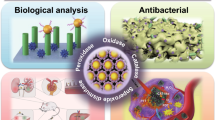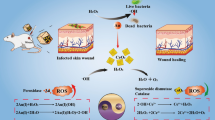Abstract
To tackle the rise of antibiotic resistant pathogenic microbes, iron withdrawal agents have shown considerable promise as antibiotic alternatives due to the microbes’ irreplaceable metabolic need for the essential element iron. DIBI is a water-soluble, linear co-polymer functionalized with 3-hydroxy-pyridin-4-one (HPO) chelators that selectively and strongly bind iron(III) in biological environments. Compared to HPO congeners, DIBI has over 1000 times higher antimicrobial activity against a broad-spectrum of Gram-(+) and Gram-(−) bacteria including highly antibiotic resistant clinical isolates. Herein, we explain the enhanced antimicrobial activity of DIBI by a cooperativity effect of the linear co-polymer wrapping around three iron(III) centres. DIBI’s structural and iron(III) binding properties were investigated by comparative experiments against HPO monomer and deferiprone using chemical and physical characterization methods with direct biological implications such as pH stability, reductive off-loading of bound iron(III), trans-membrane permeability, and competition experiments with vertebrate transferrin class iron carrier. The three iron(III) ions bound to DIBI are preferentially incorporated into a tris-bidentate chelates, which forces the linear backbone of the polymer to wrap around the complexes, as the bound iron was much less susceptible to dithionite reduction than the tris iron(III) complexes of HPO monomers and deferiprone. The results suggest a high degree of cooperativity of the polymer-bound HPO groups to effect a wrapping of the polymer backbone around the chelated iron, shielding the iron(III) centres from ready access by microbes. The structural effect of DIBI is compared to polymers containing 3-hydroxy-pyridin-4-one chelators that do not undergo this wrapping effect.












Similar content being viewed by others
References
Ang MTC, Gumbau-Brisa R, Allan DS et al (2018) DIBI, a 3-hydroxypyridin-4-one chelator iron-binding polymer with enhanced antimicrobial activity. MedChemComm 9:1206–1212. https://doi.org/10.1039/C8MD00192H
Barrasa-Villar JI, Aibar-Remón C, Prieto-Andrés P et al (2017) Impact on morbidity, mortality, and length of stay of hospital-acquired infections by resistant microorganisms. Clin Infect Dis Off Publ Infect Dis Soc Am 65:644–652. https://doi.org/10.1093/cid/cix411
del Parquet MC, Savage KA, Allan DS et al (2018) Novel iron-chelator DIBI inhibits Staphylococcusaureus growth, suppresses experimental MRSA infection in mice and enhances the activities of diverse antibiotics in vitro. Front Microbiol. https://doi.org/10.3389/fmicb.2018.01811
Devanur LD, Neubert H, Hider RC (2008) The fenton activity of iron(III) in the presence of deferiprone. J Pharm Sci 97:1454–1467. https://doi.org/10.1002/jps.21039
El-Gendy N, Qian J, Eshelman K et al (2015) Antibiotic activity of iron-sequestering polymers. Biomacromol 16:1480–1488. https://doi.org/10.1021/bm5016392
Feng MH, van der Does L, Bantjes A (1993) Iron(III)-chelating resins. 3. Synthesis, iron(III)-chelating properties, and in vitro antibacterial activity of compounds containing 3-hydroxy-2-methyl-4(1H)-pyridinone ligands. J Med Chem 36:2822–2827. https://doi.org/10.1021/jm00071a013
Frieri M, Kumar K, Boutin A (2017) Antibiotic resistance. J Infect Public Health 10:369–378. https://doi.org/10.1016/j.jiph.2016.08.007
Gans P, Sabatini A, Vacca A (1996) Investigation of equilibria in solution. Determination of equilibrium constants with the HYPERQUAD suite of programs. Talanta 43:1739–1753. https://doi.org/10.1016/0039-9140(96)01958-3
Ganz T (2018) Iron and infection. Int J Hematol 107:7–15. https://doi.org/10.1007/s12185-017-2366-2
Holbein BE, Mira de Orduña R (2010) Effect of trace iron levels and iron withdrawal by chelation on the growth of Candida albicans and Candida vini. FEMS Microbiol Lett 307:19–24. https://doi.org/10.1111/j.1574-6968.2010.01956.x
Huang X, Lu D, Ma Y et al (2019) From small deferiprone to macromolecular micelles: self-assembly enhances iron chelation. J Colloid Interface Sci 533:375–384. https://doi.org/10.1016/j.jcis.2018.08.086
Kim C-M, Shin S-H (2009) Effect of iron-chelator deferiprone on the in vitro growth of Staphylococci. J Korean Med Sci 24:289–295. https://doi.org/10.3346/jkms.2009.24.2.289
Kontoghiorghes GJ (1995) New concepts of iron and aluminium chelation therapy with oral L1 (deferiprone) and other chelators. A review. Analyst 120:845–851. https://doi.org/10.1039/AN9952000845
Lesic B, Foulon J, Carniel E (2002) Comparison of the effects of deferiprone versus deferoxamine on growth and virulence of Yersinia enterocolitica. Antimicrob Agents Chemother 46:1741–1745. https://doi.org/10.1128/AAC.46.6.1741-1745.2002
Li J, Olaleye ED, Kong X et al (2016) Macromolecular iron-chelators via RAFT-polymerization for the inhibition of methicillin-resistant Staphylococcusaureus growth. Polymer 87:64–72. https://doi.org/10.1016/j.polymer.2016.01.073
Liu ZD, Hider RC (2002) Design of clinically useful iron(III)-selective chelators. Med Res Rev 22:26–64. https://doi.org/10.1002/med.1027
Moniz T, Silva D, Silva T et al (2015) Antimycobacterial activity of rhodamine 3,4-HPO iron chelators against Mycobacterium avium: analysis of the contribution of functional groups and of chelator’s combination with ethambutol. MedChemComm 6:2194–2203. https://doi.org/10.1039/C5MD00456J
Naylor NR, Atun R, Zhu N et al (2018) Estimating the burden of antimicrobial resistance: a systematic literature review. Antimicrob Resist Infect Control 7:58. https://doi.org/10.1186/s13756-018-0336-y
Nurchi VM, Crisponi G, Pivetta T et al (2008) Potentiometric, spectrophotometric and calorimetric study on iron(III) and copper(II) complexes with 1,2-dimethyl-3-hydroxy-4-pyridinone. J Inorg Biochem 102:684–692. https://doi.org/10.1016/j.jinorgbio.2007.10.012
Palmer LD, Skaar EP (2016) Transition metals and virulence in bacteria. Annu Rev Genet 50:67–91. https://doi.org/10.1146/annurev-genet-120215-035146
Parquet MDC, Savage KA, Allan DS et al (2019) Antibiotic-resistant Acinetobacter baumannii is susceptible to the novel iron-sequestering anti-infective DIBI in vitro and in experimental pneumonia in mice. Antimicrob Agents Chemother. https://doi.org/10.1128/AAC.00855-19
Qian J, Berkland C (2019) Conformational stability effect of polymeric iron chelators. iScience 21:124–134. https://doi.org/10.1016/j.isci.2019.10.022
Savage KA, del Parquet MC, Allan DS et al (2018) Iron Restriction to clinical isolates of Candida albicans by the Novel Chelator DIBI inhibits growth and increases sensitivity to azoles in vitro and in vivo in a murine model of experimental vaginitis. Antimicrob Agents Chemother. https://doi.org/10.1128/AAC.02576-17
Singh S, Epemolu RO, Dobbin PS et al (1992) Urinary metabolic profiles in human and rat of 1,2-dimethyl- and 1,2-diethyl-substituted 3-hydroxypyridin-4-ones. Drug Metab Dispos 20:256–261
Thompson MG, Corey BW, Si Y et al (2012) Antibacterial activities of iron chelators against common nosocomial pathogens. Antimicrob Agents Chemother 56:5419–5421. https://doi.org/10.1128/AAC.01197-12
Trammer B, Kardziev B, Schmidt M, Hoegger P (2020) Analysis of fenoterol and ipratropium transfer from human lung tissue into human plasma using a dynamic dialysis model. J Pharm Res Int. https://doi.org/10.9734/BJPR/2014/9993
Weinberg ED (2009) Iron availability and infection. Biochim Biophys Acta 1790:600–605. https://doi.org/10.1016/j.bbagen.2008.07.002
Weinberg ED (2010) The hazards of iron loading. Metallomics 2:732–740. https://doi.org/10.1039/C0MT00023J
WHO | WHO publishes list of bacteria for which new antibiotics are urgently needed. In: WHO. https://www.who.int/mediacentre/news/releases/2017/bacteria-antibiotics-needed/en/. Accessed 15 Dec 2017
Workman DG, Hunter M, Dover LG, Tétard D (2016) Synthesis of novel Iron(III) chelators based on triaza macrocycle backbone and 1-hydroxy-2(H)-pyridin-2-one coordinating groups and their evaluation as antimicrobial agents. J Inorg Biochem 160:49–58. https://doi.org/10.1016/j.jinorgbio.2016.04.018
Zhou T, Neubert H, Liu DY et al (2006) Iron binding dendrimers: a novel approach for the treatment of haemochromatosis. J Med Chem 49:4171–4182. https://doi.org/10.1021/jm0600949
Zhou Y-J, Kong X-L, Li J-P et al (2015a) Novel 3-hydroxypyridin-4-one hexadentate ligand-based polymeric iron chelator: synthesis, characterization and antimicrobial evaluation. MedChemComm 6:1620–1625. https://doi.org/10.1039/C5MD00264H
Zhou YJ, Liu MS, Osamah AR et al (2015b) Hexadentate 3-hydroxypyridin-4-ones with high iron(III) affinity: design, synthesis and inhibition on methicillin resistant Staphylococcus aureus and Pseudomonas strains. Eur J Med Chem 94:8–21. https://doi.org/10.1016/j.ejmech.2015.02.050
Acknowledgements
Funding for this research was provided by NRC and Chelation Partners Inc. Additional support was provided by Canada Foundation of Innovation, Nova Scotia Research Fund and Cape Breton University. MIC experiments were conducted by Maria del C. Parquet, Kimberly A. Savage and Dave S. Allan of Chelation Partners Inc. The authors would like to thank Brian J. MacLean of St. Xavier University, Nova Scotia, Canada and Sabine Laschat of University of Stuttgart, Germany for discussions during manuscript preparation.
Author information
Authors and Affiliations
Corresponding author
Additional information
Publisher's Note
Springer Nature remains neutral with regard to jurisdictional claims in published maps and institutional affiliations.
Electronic supplementary material
Below is the link to the electronic supplementary material.
Rights and permissions
About this article
Cite this article
Gumbau-Brisa, R., Ang, M.T.C., Holbein, B.E. et al. Enhanced Fe3+ binding through cooperativity of 3-hydroxypyridin-4-one groups within a linear co-polymer: wrapping effect leading to superior antimicrobial activity. Biometals 33, 339–351 (2020). https://doi.org/10.1007/s10534-020-00253-1
Received:
Accepted:
Published:
Issue Date:
DOI: https://doi.org/10.1007/s10534-020-00253-1




